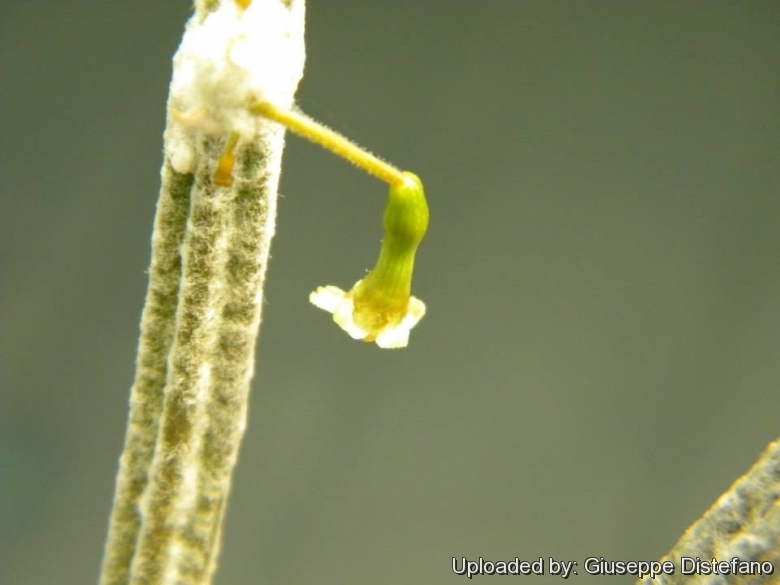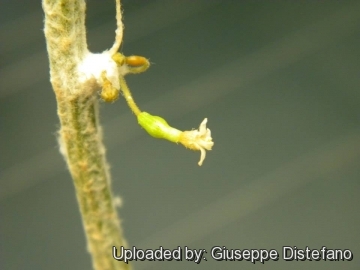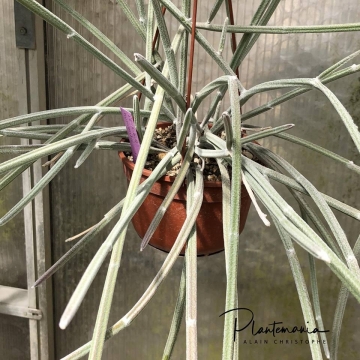




Your support is critical to our success.
Bull. Soc. Bot. France 107(7–8): 299. 1960 [Feb 1961]
Family: CUCURBITACEAE

Origin and Habitat: Seyrigia humbertiiSN|26434]]SN|26434]] is endemic to Toliara, Madagascar. It is known only from 2-5 localities from Atsimo and Andrefana regions.
Altitude: 0-500 metres above sea level.
Habitat: It grows in subarid bushlands and forests.
Synonyms:
- Seyrigia humbertii Keraudren
ENGLISH: Hidden Testicles
Description: Seyrigias are not famous in cultivation. The most known of them is Seyrigia humberti a curious succulent cucurbit from Madagascar that has small potato like tubers that look like testicles and remarkable white felt covered vines that protect themselves from hot and bright sun. Whilst the stems are attractive the tiny flowers are outstanding. The tubers which can get 8 centimetres in diameter work as storage of water during dry periods. This tubers, often improperly considered a caudex, can easily be raised above ground level out of the pot for ease of contemplation and can look quite attractive.
Habit: Seyrigia humbertii is a dioecious herbaceous liana, that bushes when young, later clambering or climbing, and with tendrils.
Stems: Slim, vine-like, cylindrical, erect, little-branched, somewhat 4- ribbed, reddish, fleshy, up to 3-4 m (or more) long, conspicuously covered with a felt of greyish-white hairs, internodes 6-8 cm long.
Tendrils. Simple 5-20 cm long, white-pubescent.
Leaves: 3-lobed, c. 3 mm long, small usually absent (these may persist in cultivation).
Flowers: Very small orange to pinkish-brown, bland.
Male flowers: 6-8 mm long, calyx short, lobes triangular, hairy on outer face; corolla conspicuously nerved, petals pubescent at apex.
Female flowers: With pedicels 7-8 mm long, petals recurved; ovary 4-6 x 2 mm, style c. 2 mm long. stigmas papillose.
Fruit: The fruit is a tiny orange to red oblong indehiscent pumpkin.
Bibliography: Major references and further lecture
1) Werner Rauh, Herman Schwartz "Succulent and xerophytic plants of Madagascar" Volume 2 Strawberry Press, 1998
2) Clive Innes “Complete Handbook of Cacti and Succulents” Van Nostrand Reinhold Company, 01/dic/1981
3) J. K. Burras, Mark Griffiths “Manual of Climbers and Wall Plants” Timber Press, 1994
4) Alfred Byrd Graf “Tropica: color cyclopedia of exotic plants and trees for warm-region horticulture--in cool climate the summer garden or sheltered indoors” Roehrs Co., 1981

Seyrigia humbertii Photo by: Giuseppe Distefano

Seyrigia humbertii Photo by: © Plantemania
Cultivation and Propagation: Seyrigia humbertiiSN|26434]]SN|26434]] is a wonderfully weird plan from Madagascar particularly suited for in warm places with bright light. The plant is easy to cultivate and can be arranged in hanging pots or in bonsai bowls. It is a particular favourite of caudiciform plant enthusiasts.
Growth rate: Plants grow slowly and caudex take many years to enlarge. Clustering in cultivation, if grown correctly, it will reward the grower with generous displays of flowers.
Caudex exposure: The remarkable tuberous rootstock (caudex) is often raised above the soil line so that this can be seen and more readily appreciated. For best results the tuber must be exposed only when plans become mature enough, usually after several years of underground growth, as the exposed caudex will no longer increase in size once it has been lifted above the soil line. If you put their potatoes above the surface it can look attractive, but it can damage all plant, because they are adapted to live under substrate, so remember this.
Potting medium: Use a cactus mix with some clay and add extra perlite or pumice to regular soil potting soil. A gritty, very free-draining compost is suitable, and clay pots help the plants to dry out between watering. For best results, use a deep pot.
Fertilization: Need a perfect fertilizer diet in spring and autumns. Use preferably a cacti and succulents fertilizer with high potassium content including all micro nutrients and trace elements or slow release fertilizer.
Watering Needs: Water normally in the growing season during the spring and the autumn with dry periods between it. No water should ever be allowed to stand around the roots. Keep almost completely dry in winter. The swollen caudex makes it very tolerant of under watering, but watch out for over drying in greenhouses.
Hardiness: It can be difficult to get it to look its best without a good amount of heat and sun and so it is only really suited to the tropics (USDA Zones 10-11). Keep the plant cooler in winter (10-15° Celsius) , but maintain the light as bright as you can so that any growth which it may produce at this time will not be etiolated. It can be grown outdoors in the summer months to benefit from direct exposure to light, and especially exposure to high summer temperatures.
Sun Exposure: It is essential to give full sun; otherwise they will become atypical. If grown in full sun, the new growth will flower profusely in spring and summer.
Rot: Rot it is only a minor problem with pterocacti if the plants are watered and “aired” correctly. If they are not, fungicides won't help all that much. The plant turns immediately to mush when over watered, or watered out of season. Care must be given in watering, keeping them warm and wet while growing, and cooler and dry when dormant.
Maintenance: The slender stems can become very long, but some advise to help the plant by pruning the top growth in autumn to encourage it to stay compact.
Reproduction: It can be reproduced both by seeds and cuttings.. The seed should be planted in spring. Germination usually occurs within about one week to one month.
| Your Actions | |
|---|---|
| Back to Seyrigia index | |
| Back to Cucurbitaceae index | |
 |
Back to Succulents Encyclopedia index |
Privacy stantement - Terms and conditions - How to cite - About us - Feedback - Donate




